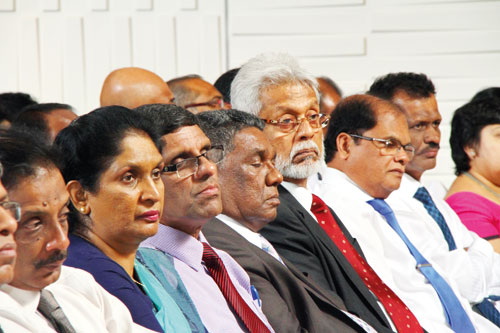Central Bank unveils ‘flexible’ inflation targeting framework

Top officials from the public and private sector at the presentation. Pic by Indika Handuwala
The Central Bank (CB) has officially announced its plan to migrate towards a flexible inflation targeting framework gradually replacing the monetary targeting framework. Inflation will remain in the mid-single digits, around 4-6 per cent this year.
This announcement was made by CB Governor Indrajit Coomaraswamy when he unveiled the ‘Road Map: Monetary and financial sector policies for 2017 and beyond’ in Colombo this week.
Under this initiative, it has been planned to stabilise inflation in mid single digits over the medium term while supporting economic growth objectives and flexibility in exchange rate management.
A joint effort has been made by the CB and the IMF in developing a structural model base Forecasting and Policy Analysis System to strengthen the monetary policy decision-making process and to support Sri Lanka’s transition to a flexible inflation targeting regime.
Addressing a media conference which followed the unveiling of the road map, Dr. Coomaraswamy said that Sri Lanka’s economic growth would be around 5.5-6 per cent in 2017, up from an estimated 4.5-5 per cent in 2016.
However he noted that there is a downside risk in the economic growth from the drought and challenges from international risks such as Brexit, the recent US presidential election and interest rate hikes by the US Federal Reserve, and the forthcoming elections in France and Germany.
“If current drought conditions prevail, there could be adverse implications on price levels, while impacting economic activities, notably agriculture and power generation,” Dr. Coomaraswamy said.
Referring to the current depreciation of rupee, he noted that Sri Lanka cannot continuously defend an exchange rate, spending much needed forex reserves.
“A properly designed and widely accepted framework for exchange rate management will also be introduced to establish a market- based exchange rate system in the country,” he said adding that maintaining artificial stable rates by CB intervention is highly unsuitable.
Revealing details of the past practice of wasting large amounts of the country’s external reserves, much of it borrowed to defend the currency, he noted that in 2011-2012, the Sri Lanka rupee fell 14 per cent after spending US $4 billion to defend the currency.
In 2015, the rupee fell 6.5 per cent after spending $2.1 billion to defend the currency.
This effort was in vain as it has failed to defend the depreciating currency.
The projected slowdown in the Chinese economy, as well as economic conditions in Sri Lanka’s major trading partners, including India, Japan, Russia and the Middle East, will also have a significant influence on the domestic economy, he added


